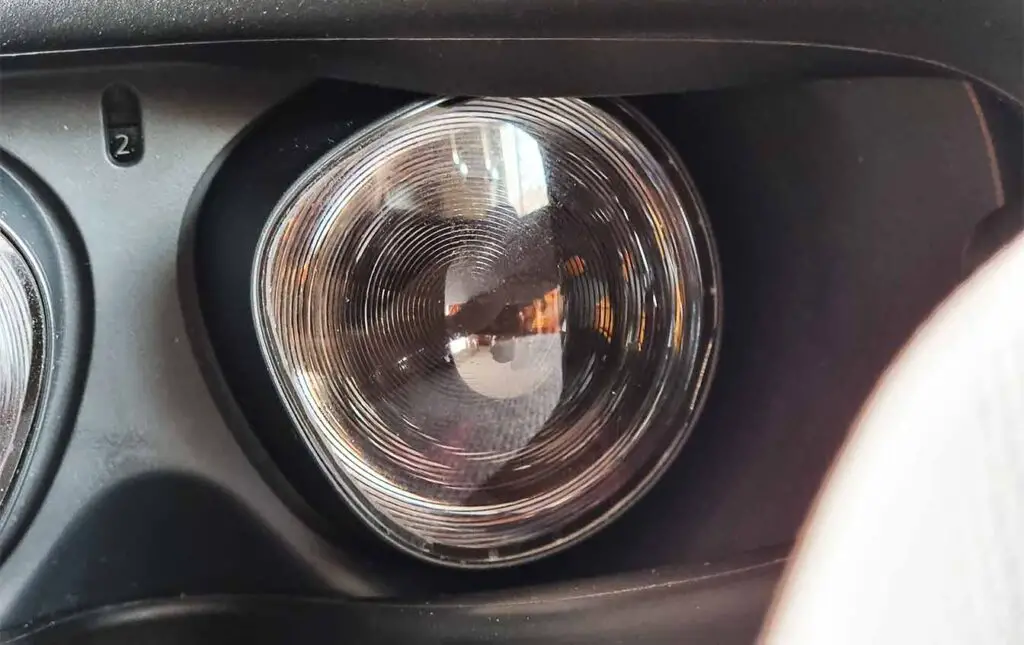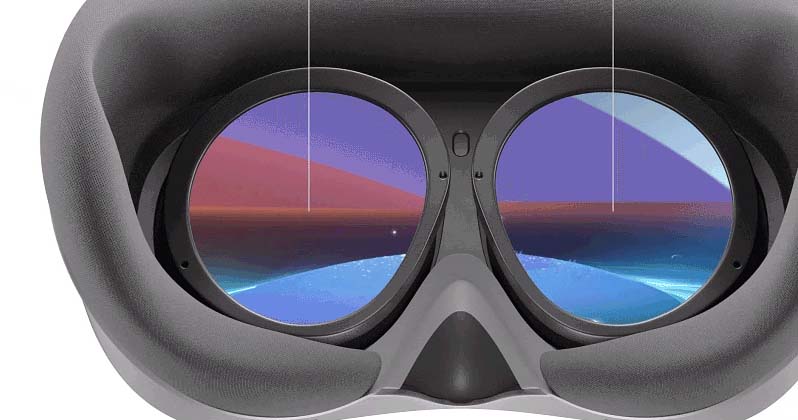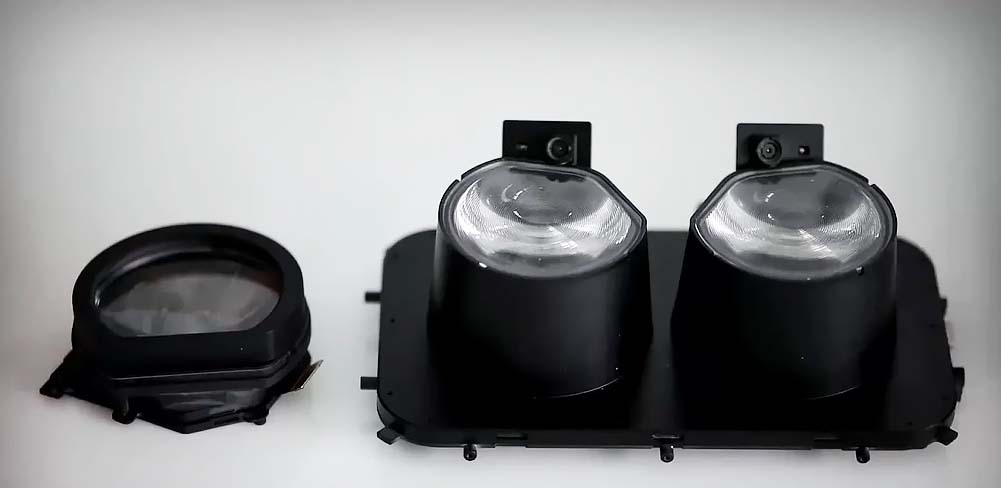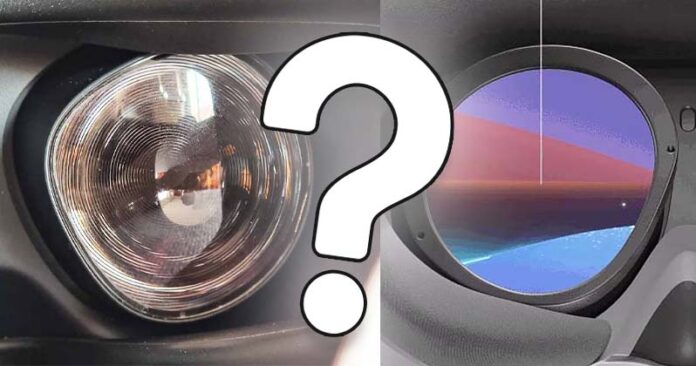Which types of lenses are best for virtual reality headsets? Here are some science backed arguments for and against each type of lenses most commonly used in modern VR goggles, alongside with the list of pros and cons for each of the solutions. Are Fresnel lenses or Pancake lenses better for virtual reality goggle experiences and VR gaming? What is the future of VR headsets in terms of the lens technology? Let’s take a deep dive in the wonderful world of VR optics to find out!
In this article, we won’t be really focusing on the maths & physics of lenses and light refraction, albeit this is a really interesting and broad topic all by itself. If you want to know more about the Fresnel lenses and the much newer Pancake lenses from the strictly scientific side, check out the resources dedicated to both of these (click the names in this very sentence to view them).
- Fresnel Lenses in VR Equipment
- Pancake Lenses in VR Equipment
- Fresnel vs. Pancake Lenses For Virtual Reality Headsets
- Modern VR Headsets Featuring Pancake Lenses
- The Conclusion – Which Ones Are Better In The End?
You might also like: Quest 2 Today – Hands On Review (Still Worth It?)
This web portal is reader-supported, and is a part of the Amazon Services LLC Associates Program and the eBay Partner Network. When you buy using links on our site, we may earn an affiliate commission!
Fresnel Lenses in VR Equipment

Fresnel lenses are first and foremost, the cheaper and more popular option used in VR headsets today – they are so widespread in fact, that even one of the most popular standalone VR headsets on the market – the Oculus Quest 2, has a pair of Fresnel lenses on board.
These kind of lenses are build in such a way that they feature characteristic circular ridges that can be rather easily seen once you look up close inside a VR headset that has them built in. On the image above you can see the Fresnel lenses used in the Meta Quest 2.
These ridges are the vital mechanic component of the Fresnel lens itself, but while being able to offer a wide field of view, good lower light level performance and relatively low production costs, they introduce quite a few disadvantages for an average VR headset user. Let’s take a look at a few of the most cons of Fresnel lenses.
Fresnel lenses commonly suffer from these problems:
- They are quite bulky – a headset making use of Fresnel lenses has to have enough space to accommodate them, and they are quite large, especially depth-wise. With this, comes the fact that VR headsets with Fresnel lenses require more distance from the lenses to the display – or in other words, from your eyes to the internal screen. Pancake lenses improve on that immensely, as you’ll see in a short while.
- Their production is quite cost efficient – industrial production of small scale Fresnel lenses is relatively easy and there are already quite a lot of manufacturers that make and sell Fresnel lenses designated for the VR market. With this situation going on, until the Pancake lenses take over, using Fresnel lenses will be the more cost-effective option for virtual reality headset manufacturers and designers.
- Better FOV compared to Pancake lenses – Fresnel lenses can provide a little bit better perceivable field of view values in VR contexts, although keep in mind that FOV values do depend on many different factors such as the distance from your eyes to the lenses and the displays, display size, as well as your current IPD setting on your headset. Did you know that the standalone Pico 4 VR headset which makes use of Pancake lenses actually on average gives better FOV results than the Meta Quest 2?
- The ridge design introduces god rays – Yes, the ridge design which the Fresnel lenses do make use of, introduces many unwanted light scattering phenomena such as the so-called “god-rays”. In practice, this means that when using a VR headset with Fresnel lenses on board, the image on the edges of your field of view will be visibly less sharp and more blurry. An interesting thing is, that this phenomenon isn’t really as distracting as it sounds like (as you can see in our Meta Quest 2 hands-on review).
- Smaller “sweet-spot” compared to Pancake lenses – this has to do with the previous point. The space in the middle of the screen where the image is the most sharp and undistorted is noticeably larger on the headsets which make use of Pancake lenses.
- Prone to chromatic aberration – this phenomenon, probably known well by most professional photographers among our readers, is yet another source of image distortion – this time visible as slight distortion of edges of objects displayed on-screen.
- Prone to pincushion (center-outwards) image distortion – this type of distortion is a bit different, as it needs to be corrected live using various displayed image processing techniques at the cost of computational power.
These Fresnel lenses cons are the ones that are picked up the most in all “Fresnel vs. Pancake lens” discussions. Keep in mind, that while these can look pretty scary on paper, and after reading this list you might assume that VR headsets with Fresnel lenses are simply not worth using, this is not the case. And I’m saying that after thoroughly testing the Meta Quest 2 making use of the old Fresnel lens design.
Pancake Lenses in VR Equipment

Pancake lenses are a much newer concept in VR equipment, however looking at the current virtual reality headset market, they are not yet a widespread solution.
These type of lenses offer many substantial improvements on the Fresnel lens VR applications, while introducing only a few, barely noticeable drawbacks. Let’s go over some of these.
Here are all the advantages that the Pancake lenses give you in a VR headset:
- They are wider, much thinner, and lighter than Fresnel lenses – as Pancake lenses are much lighter and more slim than Fresnel lenses, they also require less space in the actual VR headset. This means that 1 – there is more physical space inside the headset for other components, 2 – the headsets with Pancake lenses can be made lighter and more comfortable to wear.
- Little to no chromatic aberration – Pancake lenses are known for having little to no visible chromatic aberration.
- The “god-rays” issue is mostly gone – god rays are also almost completely gone thanks to the Pancake lens design.
With that said, Pancake lenses also do have some small drawbacks including their lower light efficiency when compared to Fresnel lenses, and slightly lower FOV. This simply means that using Pancake lenses calls for utilizing brighter displays, which in standalone VR headsets can cause faster battery drainage, and most importantly produces more heat which may cause discomfort during longer gaming sessions.
Fresnel vs. Pancake Lenses For Virtual Reality Headsets

All in all, Pancake lenses in VR headsets will give you visibly better image quality and better viewing comfort compared to the Fresnel lenses, having relatively few drawbacks when compared to them.
The only notable cons of Pancake lenses are the slightly limited FOV (which isn’t really an issue with a few headset design tweaks as we’ve seen on the Pico 4), and the fact that the Pancake lenses need more light than Fresnel lenses – and so, need to be paired with brighter displays.
Their higher production cost is also one of the things to note, although that really depends on the particular lens manufacturer, and it’s bound to change with time as more virtual reality headsets making use of Pancake lenses emerge on the market.
Fresnel lenses are usually cheaper, but they are also quite bulky, and their design has many flaws that affect and limit their magnified image quality. Among these cons that we’ve already listed are pincushion distortion, chromatic aberration, and the lenses suffering from the “god-rays” issue.
To sum it up, if you’re choosing your new headset and simply want to know which kind of lenses are really “better” – Pancake or Fresnel, the technical answer would be – Pancake lenses are generally better for VR.
The longer answer as always would be: in the end, your virtual reality headset choice should be based not only on the type of lenses the headset uses, but also on the other parts of the device specification, among them the display resolution, max screen refresh rate and wearing comfort.
The image in this section is taken from the great write-up going into the deeper technical comparison between these two type of lenses over on vrx.vr-expert.com – be sure to give it a read if you want to know more!
Check out also: Smartphone VR – Is Mobile Virtual Reality Still a Thing?
Modern VR Headsets Featuring Pancake Lenses
The shift towards using Pancake lenses in modern VR headsets is slow, but ongoing. Main reasons for that are simply the many pros of the Pancake lens design with little to no drawbacks when compared directly to the Fresnel lens technology that is currently used in most VR gear on the market.
Here are two of the most popular modern VR headsets that do feature Pancake lenses on board.
| Photo: | Model: | Features: | The price: |
|---|---|---|---|
 | Meta Quest Pro | – High resolution displays paired with Pancake lenses. – Face & eye tracking. | Check price on Amazon Check price on Ebay |
 | Pico 4 | – Higher display resolution than Quest 2. – Great FOV. | Check price on Amazon Check price on Ebay |
The Conclusion – Which Ones Are Better In The End?
So in conclusion, we can safely say that Pancake lenses are almost always the better choice when you’re going for a new VR headset. However! Keep in mind that the lenses are only one part of a VR headset as a whole. There is much more to choosing a VR headset than just comparing the lens technologies used in various different devices.
While Pancake lenses are surely a great advancement in the field of VR, you really shouldn’t base your buying decisions solely on the lens type used in your chosen headset. The overall quality of the VR experience, including the display image quality is a sum of quite a few factors, all of which are in a sense almost equally important.
With that said, in most VR contexts on average, Pancake lenses will yield better image quality than Fresnel solutions provided similar testing conditions. We hope we were able to help!

